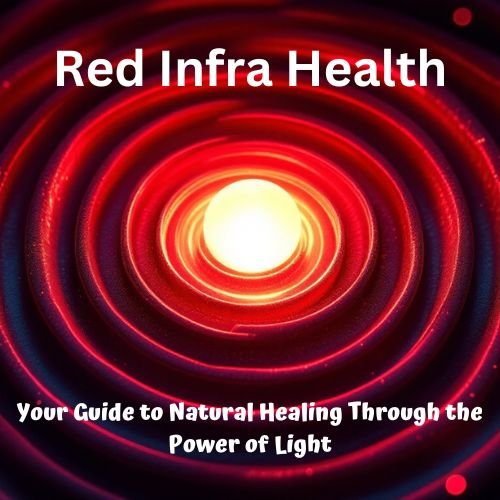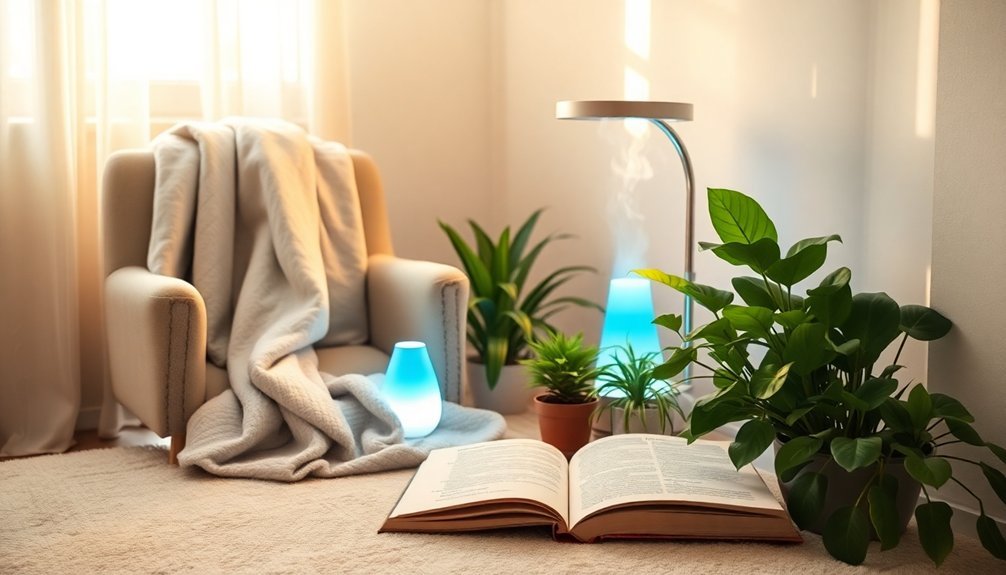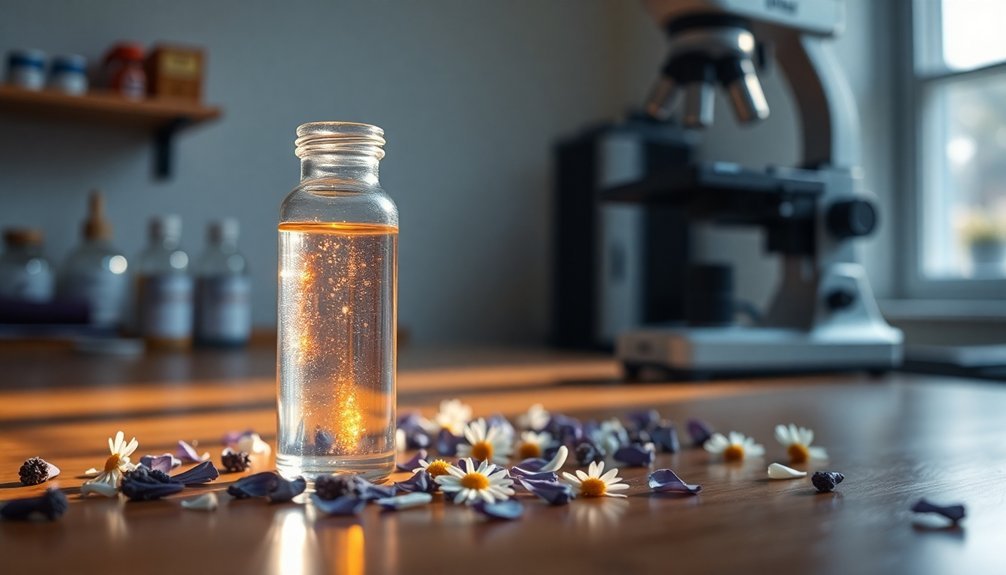You can effectively boost collagen production through heat therapy in 5 key steps. First, cleanse and exfoliate your skin thoroughly to maximize heat absorption. Next, select your preferred heat therapy method, whether it's radio-frequency treatments, micro-needling, or thermotherapy tools. Then, apply controlled heat between 40-43°C for ideal collagen stimulation, ensuring consistent temperature throughout your session. Follow up immediately with cooling and moisturizing to protect your skin. Finally, maintain results through a detailed skincare routine including vitamin C serums and sunscreen. Understanding the science behind each step will help you achieve even more dramatic collagen-boosting results.
Understanding Heat Therapy Basics

Three key mechanisms make heat therapy an effective collagen-boosting treatment. First, it dilates your blood vessels, increasing circulation and delivering essential nutrients to your skin and muscle tissues.
Second, it raises tissue temperature above 40°C, which tightens and strengthens collagen fibers.
Third, it enhances the elasticity of collagen tissues, promoting more efficient healing and regeneration. Professional treatments like radio frequency therapy can specifically target deep skin layers for optimal results.
You'll find two main types of heat therapy: moist and dry. Moist heat, delivered through hot cloths, whirlpool baths, or thermotherapy pads, penetrates deeper into your tissues because water transfers heat more effectively than air.
While dry heat options like infrared saunas can be beneficial, they're generally less efficient at tissue warming.
For ideal collagen stimulation, maintain temperatures between 41-43°C for at least three minutes. You can use various application methods, including heating pads, ultrasound, or professional treatments.
Remember that proper moisture levels are important – they'll help prevent overheating while ensuring maximum heat penetration. When applying heat therapy, always follow device guidelines and consider consulting a professional, especially if you have sensitive skin or specific skincare concerns.
Preparing Your Skin
A successful heat therapy session starts with proper skin preparation. Your skin must be thoroughly cleansed to remove any dirt, oils, or makeup that could interfere with the treatment's effectiveness.
After cleansing, exfoliate your skin gently to enhance heat absorption and guarantee better results. The enhanced absorption rate helps maximize the effectiveness of any skincare products you'll apply later.
Before starting the treatment, you'll need to think about your skin's current condition. If you have active acne, rosacea, open wounds, or recent scars, you should postpone heat therapy or consult a dermatologist first.
For sensitive skin types, start with lower temperatures and gradually increase them as your skin adapts.
Understanding your skin's structure is vital for the best results. The dermis layer, which contains most of your collagen fibers, responds to temperatures above 40°C.
Heat therapy targets this layer to tighten collagen and increase blood flow, while protecting your epidermis from damage.
Don't skip post-treatment care, as it's essential for maintaining results. After your session, cool your skin and apply a hydrating moisturizer.
Protect your skin from direct sunlight and maintain your regular skincare routine. Remember to avoid harsh products that might irritate your skin during this process.
Choosing Your Treatment Method

When considering heat therapy options for collagen production, you'll find several effective methods to choose from. Radio-frequency treatments offer a non-invasive approach, using controlled heat above 40 degrees Celsius to tighten existing collagen fibers in your dermis while stimulating new production. For optimal results, combine treatments with proper sunblock protection daily.
If you're looking for a more targeted approach, micro-needling combined with heat therapy creates tiny, controlled injuries that trigger your body's natural collagen production. This method works particularly well for addressing acne scars and stretch marks while tightening your skin.
For a gentler option, thermotherapy tools improve blood circulation and enhance your skin's ability to absorb serums. You'll notice improved skin tone and reduced inflammation, though you'll need to be careful when applying heat to sensitive facial areas.
Laser treatments, particularly Fraxel, offer precise control over heat delivery and create microscopic columns of controlled damage. While you'll experience some downtime, this method effectively resurfaces stubborn wrinkles and stimulates collagen production in specific areas.
Each treatment method varies in intensity and recovery time, so you'll want to choose based on your skin's needs and your schedule's flexibility.
Heat Application Techniques
Successful heat therapy for collagen production depends on precise temperature control and proper application techniques. You'll want to maintain temperatures between 40°C and 70°C, as this range effectively stimulates collagen production without causing tissue damage. The fibroblast activation process begins immediately when the correct temperature is achieved.
When using radiofrequency (RF) devices, the high-frequency alternating current generates targeted heat in your deep skin layers, promoting collagen synthesis and tightening.
Consider your treatment duration carefully, as it's just as vital as temperature control. You can achieve similar results with longer exposure at lower temperatures or shorter sessions at higher temperatures. For instance, a 2-hour session at 50°C can be as effective as briefer treatments at higher temperatures.
- Apply heat consistently and monitor your skin's response, as different tissues react uniquely to heat therapy
- Adjust treatment duration based on the temperature you're using – lower temperatures require longer exposure
- Focus on maintaining steady heat levels rather than intermittent application for ideal collagen stimulation
Remember that your skin and tendons will respond more readily to heat treatment than bone tissue, so target your therapy accordingly. Using RF technology allows for precise control over both temperature and depth of penetration.
Maintaining Collagen Production Results

After completing your heat therapy sessions, maintaining collagen production results requires a meticulous approach that combines lifestyle changes and targeted treatments. You'll need to focus on both internal and external factors to preserve your skin's improved condition.
Protect your investment by adopting an extensive skincare routine that includes hyaluronic acid products and vitamin C serums. Don't skip your daily sunscreen, as UV exposure can quickly reverse your progress by damaging collagen fibers. Regular use of chemical peels can help maintain results by continuously encouraging new skin cell formation.
You'll want to complement these topical treatments with regular microneedling sessions every 4-6 weeks to maintain stimulated collagen production.
Support your skin from within by consuming collagen supplements and vitamin C-rich foods. You'll see better results if you also eliminate harmful habits like smoking and minimize exposure to environmental pollutants. Regular exercise will boost blood circulation, enhancing your skin's natural collagen production.
Consider combining multiple maintenance methods for superior results. Red light therapy sessions can work alongside your existing routine, while stress reduction techniques will help prevent premature collagen breakdown.
Frequently Asked Questions
Can Heat Therapy for Collagen Boost Interfere With Existing Dermal Fillers?
Yes, heat therapy can affect your dermal fillers. If you've got fillers, you'll want to choose heat-resistant types like HA-PEG gels and avoid excessive heat that could degrade them prematurely.
How Soon After Sunburn Can I Safely Undergo Heat Therapy Treatments?
You'll need to wait at least 4-7 days after your sunburn, when peeling has stopped and skin has begun healing. Don't start heat therapy during peak symptoms or if you have blisters.
Will Heat Therapy Affect Permanent Makeup or Microbladed Eyebrows?
Yes, heat therapy can negatively affect your permanent makeup and microbladed eyebrows. You'll risk fading, discoloration, and poor pigment retention. It's best to avoid heat treatments, especially during the initial healing period.
Does Taking Blood Thinners Impact the Safety of Collagen-Stimulating Heat Treatments?
If you're on blood thinners, you'll need extra caution with heat treatments. They can increase your risk of bleeding. Always consult your doctor first and avoid high temperatures that could cause tissue damage.
Can Heat Therapy Treatments Trigger Cold Sore Outbreaks in Prone Individuals?
Yes, if you're prone to cold sores, heat therapy could potentially trigger an outbreak. The thermal stress and increased blood flow might activate the dormant virus, though there's no direct scientific evidence confirming this link.
In Summary
You'll see noticeable improvements in your skin's collagen production by consistently following these heat therapy steps. Remember to maintain proper temperature levels, stay hydrated, and protect your treated skin from UV damage. Don't skip your aftercare routine, and you'll maximize the long-term benefits. For best results, combine heat treatments with a collagen-boosting diet and skincare regimen. Now you're ready to enjoy firmer, more youthful-looking skin.





Leave a Reply